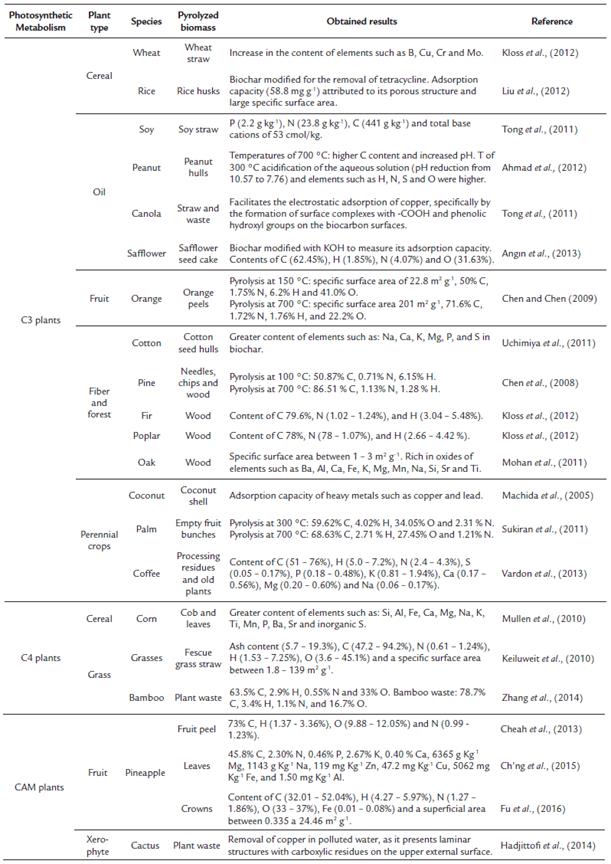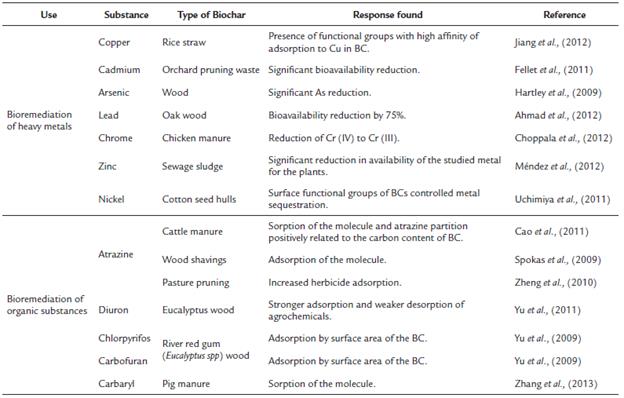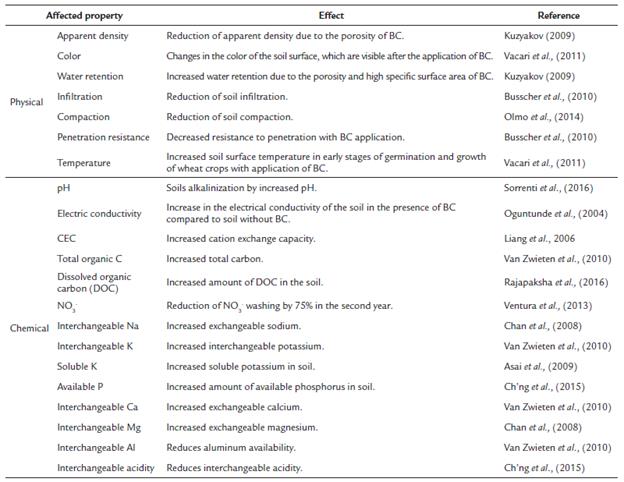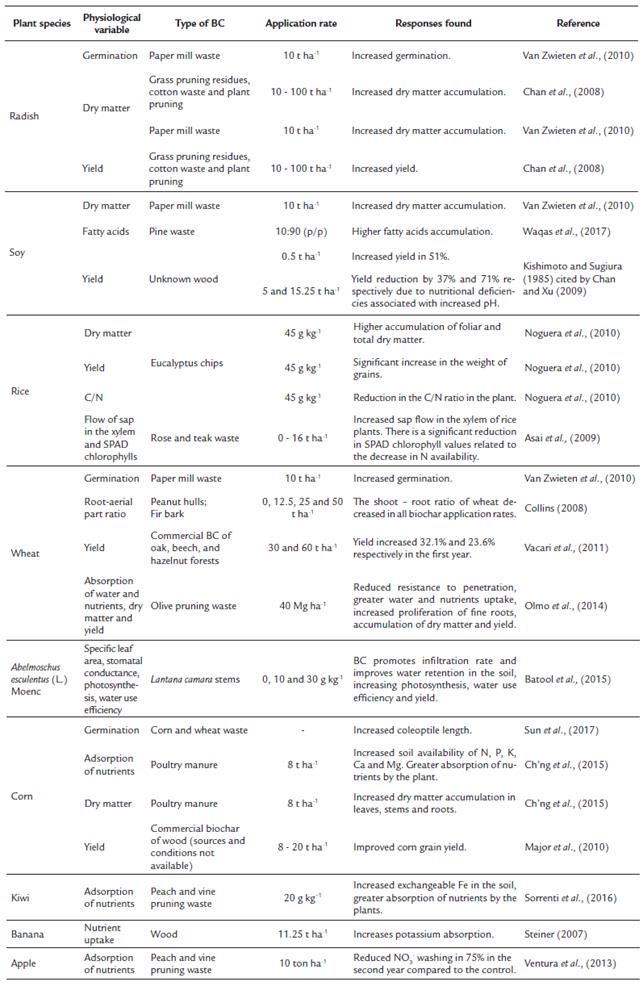INTRODUCTION
The concentration of atmospheric CO2 is currently ~417 mg kg-1 and this concentration has increased continuously as a result of human activities, such as industrial processes and changes in land use and agricultural practices. Atmospheric CO2 along with other gases, cause a warming effect of the planet, negatively affecting the soil's chemical, physical and biological properties (Pak et al., 2016). Biochar (BC) is a viable option to face global warming because it helps carbon sequestration, which improves crop yield (Lehmann and Joseph, 2009). BC has also shown the potential to improve conventional agricultural productivity and profitability of farmers by favoring the plant nutritional status (Atkinson et al., 2010).
The origin and use of BC as a source to improve soil fertility is reported in the dark Amazonian lands locally known as "Terra Preta do Indio" (TPI) (Lehmann and Joseph, 2009). The soils of this Amazonian region have an A horizon, which is rich in carbon and nutrients (indicators of soil quality). It is a result of the accumulation of organic vegetable and animal residues which have been subjected to the intensive use of fire (de Sousa et al., 2015). Therefore, BC has been defined as a product rich in carbon that comes from the heating of biomass such as wood, manure or leaves in a closed container with little or no air availability (Lehman and Joshep, 2009). However, Shackley et al. (2012) also defined BC as biomass that has been pyrolyzed, and that has suitable physical-chemical properties for the safe and long-term storage of carbon in the environment. It involves a change in the chemical composition of the raw material, and it is irreversible.
Biochar can bring significant benefits when applied to agricultural soils in combination with some fertilizers (Schulz et al., 2013). An increase in crop yield from 45 to 250 % has been reported, when BC is used in mineral nutrition plans of crops, such as radish, rice, corn and wheat (Atkinson et al., 2010; Biederman and Harpole, 2013). The water retention properties of the soil, saturated hydraulic conductivity, and nutrient availability have also been optimized with BC application (Jeffery et al., 2016). Spokas et al. (2009) also reported that the supply of sawdust BC reduced CO2 production (associated with the respiration ofmethanotrophic microorganisms) and the synthesis of nitrous oxide and methane (observed in the reduced N2O and the lower rates of NH4 oxidation). Finally, Sohi (2012) concludes that the organic material used in the production of biochar influences the structure, porosity, as well as the density and the specific surface of BC, which favors the availability of nutrients to be subsequently absorbed by plants.
Currently, studies focused on evaluating the potential of BC as a soil amendment and carbon sink have been carried out in order to provide a solution to erosion and greenhouse gases emission problems (Sohi, 2012). However, the available information on the responses of plants grown under BC supply is still limited and need further investigation (Jha et al., 2010). Therefore, this review aims to show, in a general way, how BC is obtained by shedding light on the debate about the effects on the physical and chemical properties of soils and the physiological behavior of cultivated plants.
GENERAL ASPECTS OF BIOCHAR PRODUCTION
Biochar is obtained by the decomposition of organic matter exposed to temperatures between 200-900 °C in an inert atmosphere with low / no oxygen concentration. This process, known as pyrolysis (Sohi, 2012), is generally divided into fast, intermediate and slow depending on the residence time (time required to complete the pyrolysis process) and the exposure temperature of the biomass (Lhemann and Joseph, 2009). The first is characterized by a concise residence time and high temperatures (less than 2 seconds, > 800 °C) and is often used to produce bio-oil from biomass obtaining approximately 75 % yield (Mohan et al., 2006). The processes of slow and intermediate pyrolysis occur with a residence time of a few minutes to several hours or even days under temperatures between 300 and 800 °C, with BC yields between 25-35 % (Brown, 2009).
Different studies have shown that both the pyrolysis temperature and the material used have an effect on the production characteristics of BC for agricultural use (Sohi, 2012). Gaskin et al. (2008) stated that BC manufactured from animal waste (poultry litter) has a lower carbon content (close to 40 %), while in the one obtained from vegetable by-products (pine chips) it is close to 78 %. These authors also reported that BC produced from pine chips at a temperature of500 °C in the pyrolysis process caused a higher nutrient content (P, K, Ca, Mg), compared with a temperature of 400 °C. Finally, biochar physical and chemical qualities are also conditioned by factors such as the size and density of the pyrolyzed particle, the concentration of inorganic (ash content, Ca, Mg, and inorganic carbonates) and organic (cellulose, lignin, and hemicelluloses) compounds, and the type of waste (Lehmann and Joseph, 2009; Keiluweit et al., 2010).
BC obtained from forages, woody plants, or cacti shows different physical and chemical characteristics due to their carbon fixation metabolisms (Ahmad et al., 2014). For example, BC from CAM plants (pineapple) showed a higher content of nutrients such as N, P, K, Ca, Mg, Na, Zn, Cu, Fe, and Al (Ch'ng et al., 2015). In this sense, Table 1 shows a summary of the main plant species that have been used in biochar production, which were grouped according to their type of carbon fixation metabolism (C3, C4, and CAM).
CURRENT USES OF BIOCHAR
One of the main dilemmas of agricultural activities is the management of large volumes of organic waste, which need to be treated appropriately in order to avoid risks of pollution, soil erosion, eutrophication of water and the emission of greenhouse effect gases (Amhad et al., 2014). As a result, various technologies are currently being used for BC application. In this sense, Dias et al. (2010) concluded that eucalyptus BC could be used as a loading agent for the composting of poultry manure since it generates a positive effect that mitigates the degradation and humification of organic matter.
Another critical characteristic of BC is its sorption capacity (process by which another absorbs a material) of inorganic contaminants such as heavy metals (lead, chromium, copper, zinc, nickel, arsenic, and cadmium) from mining operations in both soil and water (Dong et al., 2011; Regmi et al., 2012; Hadjittofi et al., 2014; Trakal et al., 2014). This kind of pollution by organic substances has increased as a result of hydrocarbons exploitation, refining, storage and distribution, and bioremediation can take years to complete the restoration and recovery of impacted areas (Ferrera-Cerrato et al., 2006). Also, BC use has been reported as an exciting alternative in the cleaning of soils contaminated by agrochemicals (Ahmad et al., 2014). Many of these substances have accumulated as a result of the indiscriminate use of herbicides, insecticides, and other toxic molecules (Herath et al., 2016). For example, it has been observed that the amount of atrazine in the soil was reduced by livestock manure BC sorption (Cao et al., 2011). Also, the high surface and nano-porosity of BC favored the adsorption of insecticides based on chlorpyrifos and carbofuran (Yu et al., 2009), and decreased the levels of a pesticide such as pentachlorophenol (Xue et al., 2012). In addition, the use of BC has mitigated the contaminating impact of substances such as diclofenac (Jung et al., 2015), furfural (Li et al., 2014), glyphosate (Herath et al., 2016), ibuprofen (Jung et al., 2015; Mondal et al., 2016), levafix red (Angin et al., 2013), methylene blue (Wang et al., 2013; Zhang et al., 2014), naproxen (Jung et al., 2015) and sulfamethazine (Rajapaksha et al., 2015). Table 2 shows the main bioremediation effects of BC in soils.
The potential use of biochar as an alternative and complementary substrate in the production of seedlings in crops without soil has also been studied (Dispenza et al., 2017). Altland and Locke (2012) stated that BC-modified substrates used for the production of ornamental plants are an important source of phosphates. Bommaraju (2016) found that substrate constituted by vermicompost, peat, and BC from forest residues (50 % biochar and 50 % vermicompost) enhanced plant photosynthesis in coffee seedlings. Gu et al. (2013) also observed that biochar at a rate of 5-30 % v/v could replace commercial substrates such as peat of pine bark, moss or pearlite without generating negative impacts on Gomphrena plants growth.
EFFECTS OF BIOCHAR APPLICATION ON THE PHYSICAL-CHEMICAL PROPERTIES AND MICROBIOLOGY OF THE SOIL
BC incorporation into the soil can alter water retention because BC porosity and high specific surface area reduce the apparent density of the soil (Rajapaksha et al., 2016). Additionally, it was found that the use of BC from pecan walnut shells and grass residues may favor the increase in soil temperature because it confers a dark color which is associated with the capture of solar energy. This increase in soil temperature may benefit microbial communities and germination of seeds in soils with low temperatures (Busscher et al., 2010). Another valuable physical property that is affected by the application of BC from olive tree pruning waste is the compaction of the soil, which was reduced, allowing a more significant root proliferation (Olmo et al., 2014).
BC can also modify the chemical properties of the soil, increasing the cation exchange capacity and improving soil fertility through the availability of essential and beneficial nutrients for the plant (Liang et al., 2006). Van Zwieten et al. (2010) have reported that the use of BC improved fertility by increasing the pH and Cation Exchange Capacity (CEC) in the soil, especially at application rates of 10 t ha-1. On the other hand, Karhu et al. (2011) showed that the incorporation of 9 t ha-1 of BC into a soil used for agriculture increased the average CH4 uptake and the water retention capacity close to 96 %. Additionally, it has been reported that biochar can increase the electrical conductivity (Oguntunde et al., 2004) and reduce the exchangeable acidity (Chan et al., 2008; Ch'ng et al., 2015), which indicates that nutrients may be more available in the soil solution. Table 3 summarizes the main benefits obtained in the physical and chemical properties of the soil with the supply of biochar.
Regarding BC impact on soil microorganisms, this aspect has gotten less attention in comparison to the physical and chemical properties of the soil (Lehman et al., 2011). Anderson et al. (2011) found that BC application promotes phosphate solubilizing bacteria, altering the carbon flux in the soil to increase the abundance of bacteria families such as Streptosporangineae (~6 %), Thermomonosporaceae (~8 %), Bradyrhizobiaceae (~8 %), and Hyphomicrobiaceae (close to ~14 %) (these last two families have an important participation in the nitrogen cycle especially in the denitrification process of NO3 - to N2). These results indicate that BC application promotes phosphate solubilizing bacteria, which alter the flow of carbon in the soil and increase the abundance of these microorganisms that can degrade more recalcitrant carbon compounds and potentially reduce plant pathogenic bacteria.
BC application can condition associations between plants and microorganisms. For example, Kolton et al. (2011) found that BC incorporation in the soil enhanced bacterial communities (Flavioibacterium) associated with the root of mature sweet pepper (Capsicum annuum L.) plants. On the other hand, Warnock et al. (2010) observed that the abundance of arbuscular mycorrhizas decreased proportionally with the application of pine chip BC in Plantago lanceolata L. plants. It was found that the abundance of arbuscular mycorrhizas decreased proportionally with the application of BC, and these changes were accompanied by increases in both the pH and phosphorus availability in the soil; this indicates that the pH may be influencing the abundance mechanisms of mycorrhizae. In this sense, many of the studies have found that the microbial biomass increases as a result of BC application, but significant changes occur in the composition of the communities and in the enzymatic activities. These changes may explain the biogeochemical effects of BC on the nutrient cycle, the presence of phytopathogenic organisms and the growth of crops (Spokas et al., 2009; Elad et al., 2010; Solaima et al., 2010). However, very little is known about the mechanisms through which BC affects the abundance and composition of microbial communities (Lehman et al., 2011).
EFFECT OF BIOCHAR APPLICATION ON PLANT PHYSIOLOGY
Chan et al. (2008) observed that combined applications of BC of waste paper mills and chemical synthesis fertilizers favored the growth of radish plants since BC improved N fertilizer-use efficiencies. Also, parameters such as plant height, stem diameter, and dry matter were increased by BC in teak (Tectona grandis) seedlings. Finally, Van Zwieten et al. (2010) and Olmo et al. (2014) also found that BC improved seed germination and root growth in wheat plants.
BC application improved the absorption of nutrients in kiwi (Sorrenti et al., 2016) and apple (Ventura et al., 2013) plants. Ch'ng et al. (2015) also reported that BC (manufactured with pineapple leaves) improved the contents of nitrogen (~80 %), phosphorus (~200 %), potassium (~400 %), calcium (~100 %), and magnesium (~150 %) in corn leaves. Besides, BC can help crop quality since it favors the accumulation of fatty acids such as palmitic, stearic, oleic, and linoleic in soybean (Waqas et al., 2017). The extraction of leachates from substrates with BC supports that fact that such natural enhancer is rich in nutrients, which favor plant growth when incorporated into the soil or substrates (Bommaraju, 2016). Sun et al. (2017) evaluated the molecular properties of water-soluble extracts (WSE) of BC prepared from wheat and corn plant residues. They found that these substances promoted grain germination and increased the coleoptile length of corn seedlings, specifically in the WSE obtained from corn BC.
Studies have been reported regarding the synergistic activity between BC application and other sources of nutrients with some exceptions. In this regard, Seehausen et al. (2017) found antagonistic effects between BC application and substrates from mushroom production on the maximum leaf area and stomatal conductance of Abutilon theophrasti. For this reason, it is important not to make generalized conclusions about the synergistic effects of BC application on plant yield. In this sense, Kishimoto and Sugiura (1985) (as cited in Chan and Xu, 2009) found that the application of 5 and 15.25 t ha-1 of BC (from unknown woods) in a soybean crop affected yield, reducing it by 37 % and 71 % respectively, due to the increase in pH that caused nutritional deficiencies in the plants. Similar responses were observed by Asai et al. (2009) in the quantification of "SPAD chlorophylls", finding the lowest values in the treatments with biochar application, which was attributed to the reduction in nitrogen availability in the soil. Finally, Table 4 summarizes the main effects of biochar application on the physiological behavior in plants.
PERSPECTIVES
The use of BC opens essential opportunities for the sustainable management of agriculture in Colombia. As mentioned before, BC can be considered in systems in which vegetables are irrigated with contaminated water (Miranda et al., 2011) and in perennial crops exposed to heavy metals due to activities related to mining and hydrocarbon exploitation (Jiménez, 2015), in order to reduce their impact on human health. In this sense, the cocoa crop is cultivated in contaminated soils with high cadmium content; in these scenarios, biochar can be an important alternative in bioremediation of heavy metals (Lau et al., 2011). Another interesting opportunity is to evaluate the different sources of plant and animal material as alternatives to be used in the pyrolysis process, especially by-products such as sugar cane bagasse (Rodríguez et al., 2009), the leaves and empty fruits of oil palm crops (Sukiran et al., 2011), corn, sorghum and rice chaffs, cotton waste, as well as waste from livestock activities (pig, poultry and cattle manure). The knowledge of the effects on the physiology of cultivated plants is one of the main challenges that should be taken into consideration. A clear example is the use of solid vegetable residues of coffee production systems as the pulp obtained from the fruit processing represents about 43.58 % of the coffee fruit on a fresh weight basis (Montoya, 2006). It has been reported that about 2258 kg ha-1 of coffee pulp are produced annually (Rodríguez, 2007). Collectively, about 162 900 t of fresh pulp are generated per each million bags of 60 kg of dried parchment coffee that is exported from Colombia. Ifnot used correctly, the pollution caused by these residues would be equivalent to the one generated by the excrements and urine of a population of 868 736 inhabitants (Rodríguez, 2009). For this reason, alternatives such as the application of BC can improve the productivity, quality and profitability of farmers.
On the other hand, it has been shown that BC application causes small and potentially transitory changes in the functioning of agroecosystems (Jones et al., 2011). Studies have reported the benefits of BC used in the restoration of ecosystems with different intensities of deterioration, especially in the production of forage from alfalfa plants, where a higher forage yield and improvement in soil quality have been achieved (Fiallos-Ortega et al., 2015). This shows that the use of BC in the restoration of degraded soils in Colombia can be an exciting alternative.
CONCLUSIONS
In general terms, BC is a valuable tool that can be used in soils as a mitigation strategy for environmental pollution. It also serves as a carbon sink substance, improves the physical and chemical characteristics of the soil and has been proven to have high potential in agricultural use, increasing the yield and quality of cultivated plants. Additionally, it is an exciting alternative in the management of solid residues of vegetable (cherries obtained from coffee plants, rice husks, or pruning residues) or animal (poultry, cattle, and pig manure) origin.


















